An informative guide to homemade scallion pancakes, a layered Chinese flatbread loved for its super crispy, flaky texture and oniony, aromatic taste.
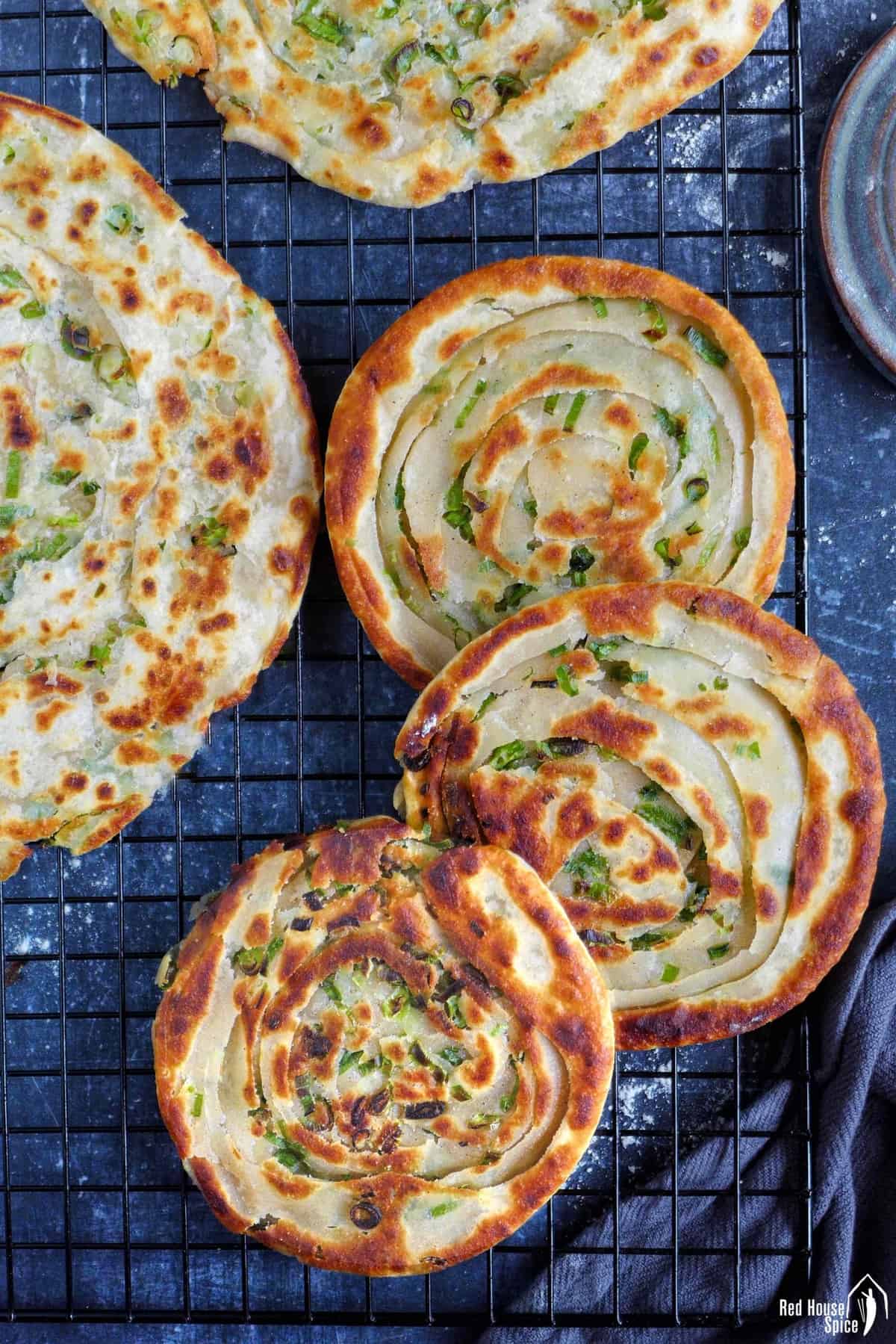
Note: This is a revised version of my blog post published in 2017. It provides more tips, substitute ideas, FAQs, and a video.
What are scallion pancakes
Scallion pancakes, aka green onion pancakes/spring onion pancakes, are a type of pan-fried pastry flavoured with chopped scallions, salt and spices. They are a traditional home-cooked dish in northern China and are also widely available in restaurants and street stalls nationwide.
Although referred to as pancakes in English, they are very different from Western-type pancakes. Instead of a batter, they’re made from a simple flour-water dough with a savoury filling between the layers. For me, “scallion oil flatbread” would be a better translation for its Chinese name Cong You Bing/葱油饼.
Like Shanghai scallion oil noodles and steamed scallion flower rolls, these pancakes are scallion-flavoured and oil-enriched. With a distinctively fragrant and savoury taste, they make a great staple to accompany any dishes, or an eat-alone snack at any time of the day.
Pro tips
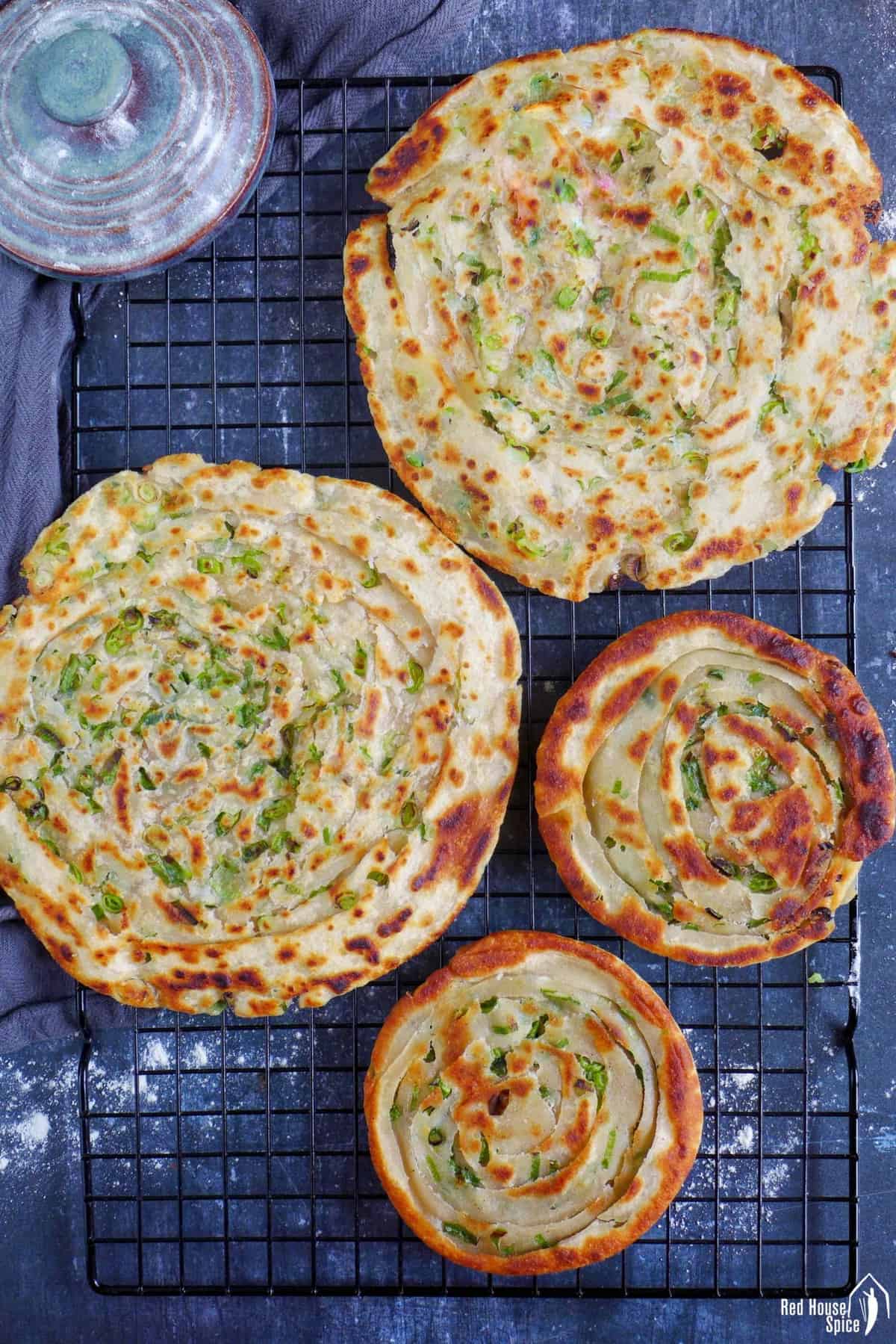
As shown in the image above, scallion pancakes can be made thin or thick. Both versions share the same features: crispy, flaky and tasty. Before explaining the recipe in detail, let me summarise a few key tips for achieving the best result.
- Make it crispy by regulating the heat properly. Start with a hot pan then cook over medium heat.
- Make it flaky by brushing a good layer of flour oil paste in between layers and rolling up loosely.
- Make it tasty by using a generous amount of fresh scallions and your favourite spice.
Make the dough
Compared to the dough for dumplings or steamed buns, the dough for scallion pancakes is simpler in all respects. So it’s totally novice-friendly.
Flour type
You can use any type of white, wheat-based flour. I list all-purpose flour in the recipe simply for its accessibility. Wholemeal flour isn’t suitable for this recipe but you can mix it with white flour. I recommend a ratio of 3:7.
Use hot water
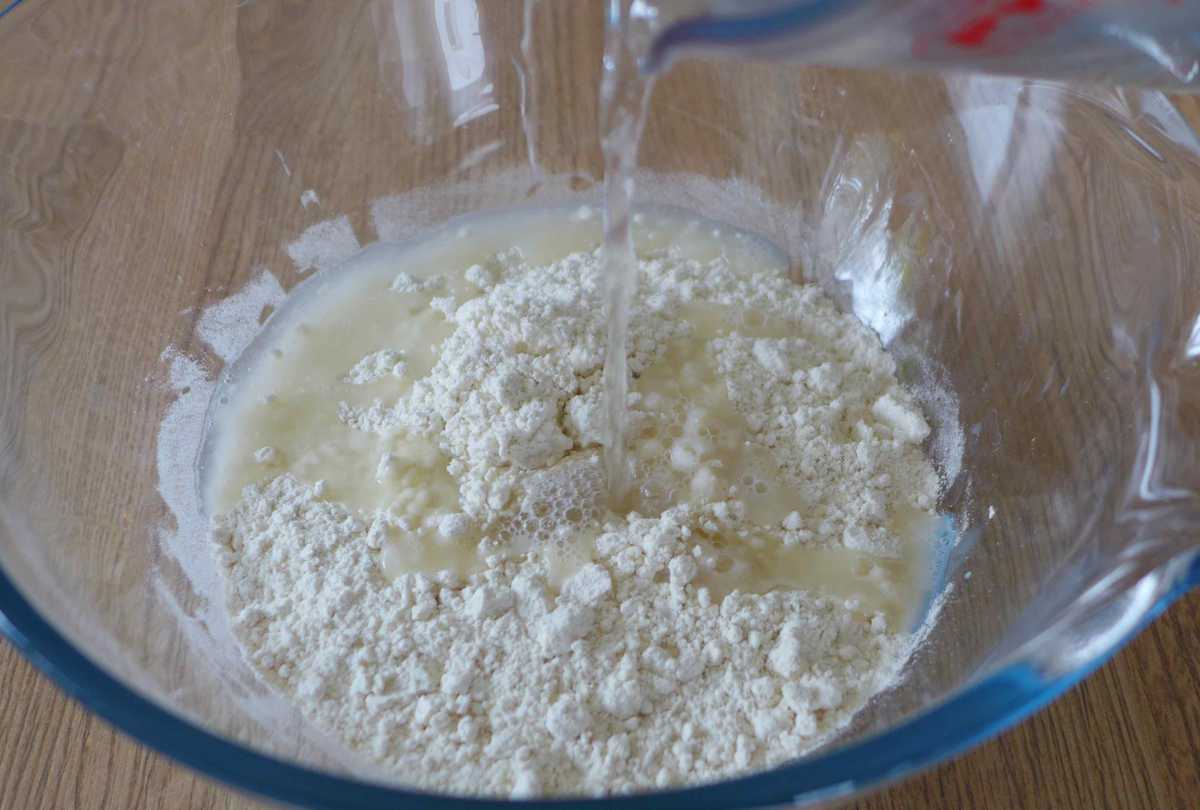
Flour and water are the only ingredients you need for the dough. Instead of room temperature water typically used in the non-yeast dough (e.g. regular dumpling dough), boiling water is added to the flour in this case.
The protein of the flour is “cooked” so the gluten network is not as tight as that of the cold water dough. This results in a more forgiving and less elastic texture thus making kneading and shaping as easy as they can be.
The ideal ratio
I recommend a flour to water ratio of around 3:2 by WEIGHT. For example, to make 4 pieces of scallion pancakes, you’d need 250g flour and 160g hot water.
I always recommend novice cooks measure with a scale to achieve the desired result. That said, if you have to use measuring cups, the above quantity could translate to 2 cups of flour and ⅔ cup of hot water.
The dough should be on the soft side but not sticky. Please feel free to adjust if necessary as the type and brand of your flour may affect the optimal ratio.
Combine and rest

In a bowl, stir and mix flour and hot water with chopsticks until there is no more loose flour. Then combine by hand to form a rough-looking dough. At this stage, it isn’t necessary to overly knead to make it smooth.
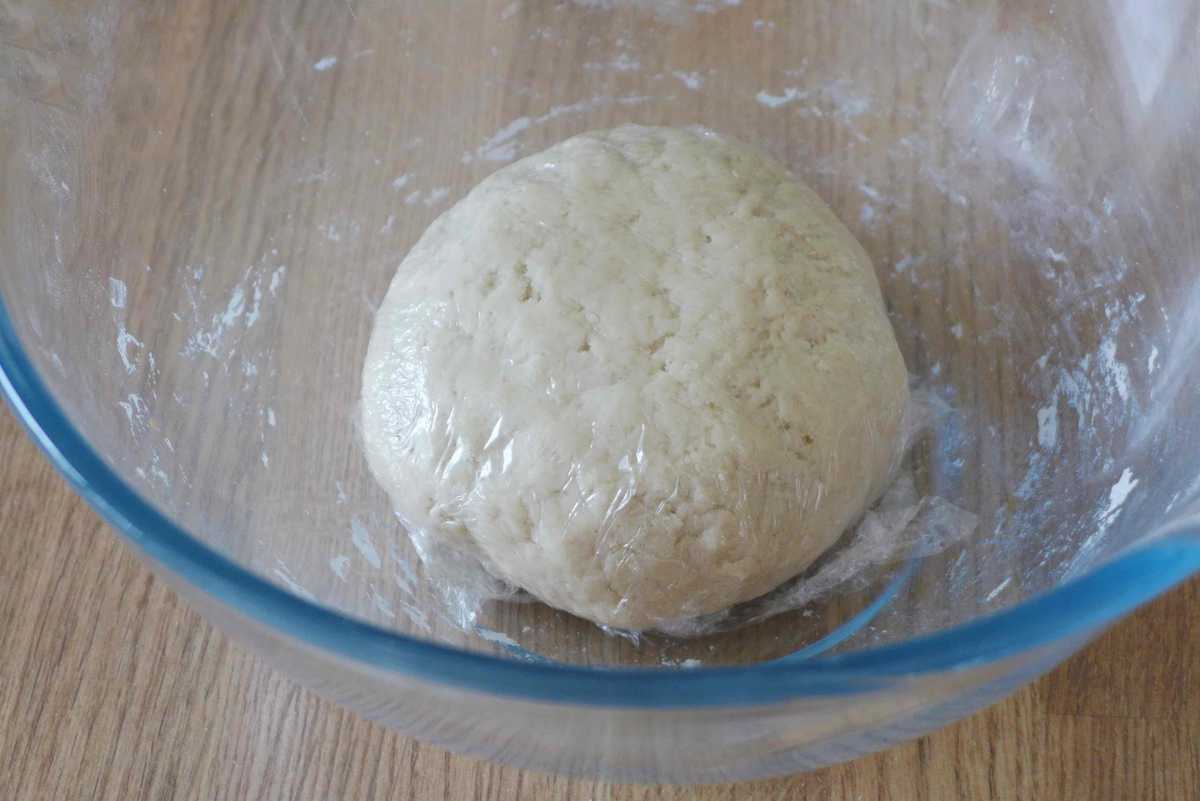
Cover the dough tightly with a piece of cling film. This is to prevent the moisture from evaporating since it’s a warm dough. Leave to rest on the counter for 15 minutes or so.
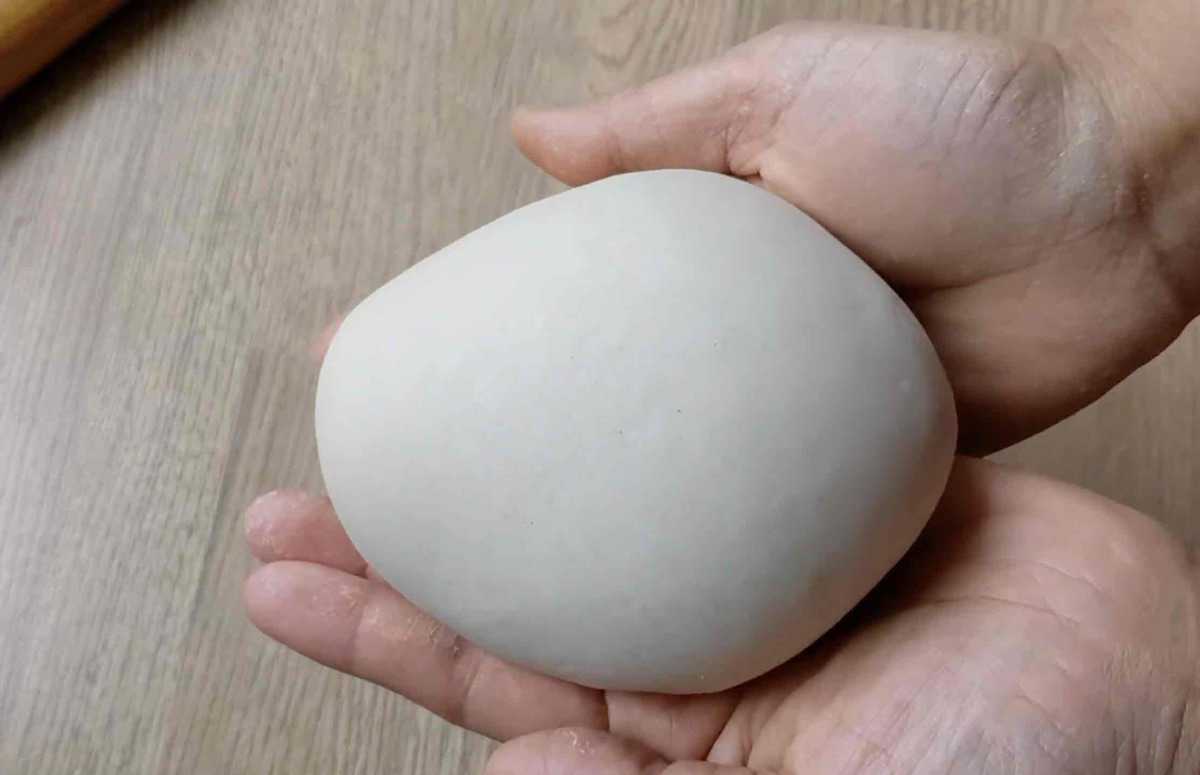
Then knead again until it becomes very smooth. Unlike working with other types of dough which require lengthy kneading, you’ll be surprised how fast this process is. It only takes 10-15 strokes to make it completely creaseless.
Prepare the filling
While waiting for the dough to rest, prepare the filling ingredients.
Scallions
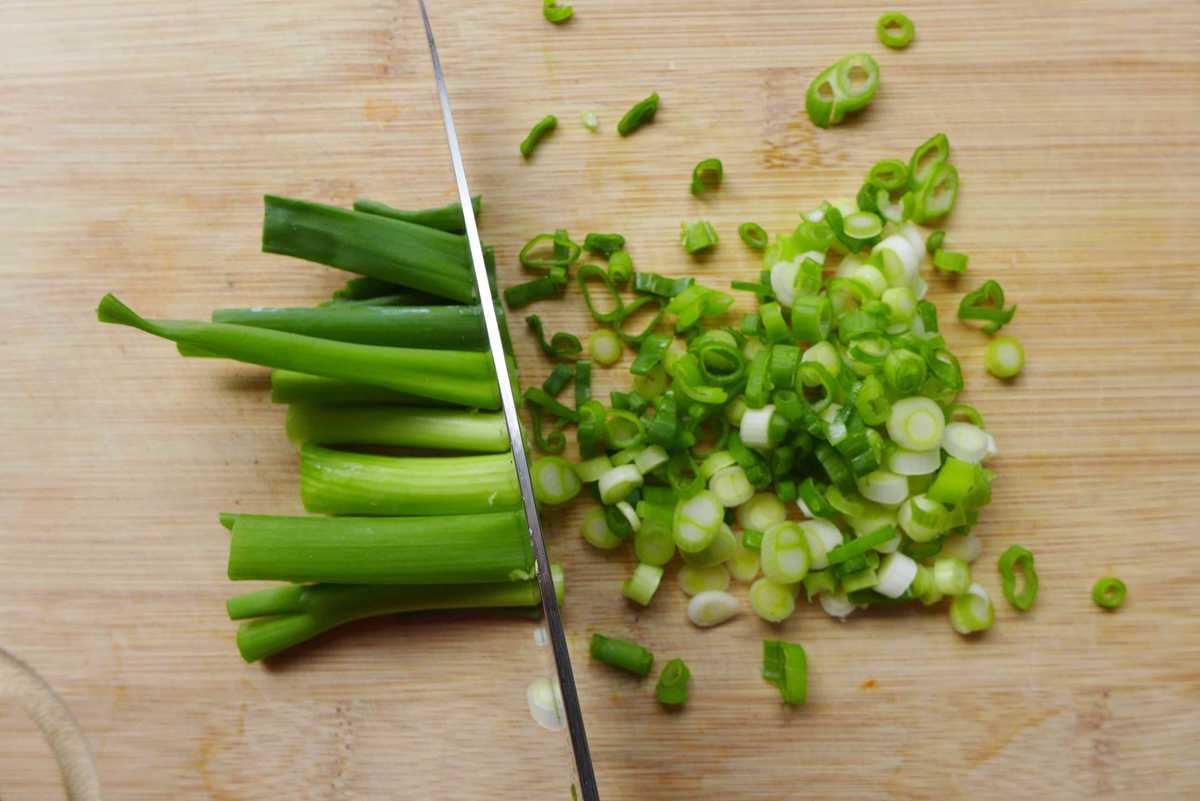
Chop scallions into fine pieces. If they’re quite thick, halve lengthwise then cut. Don’t stint on the quantity. The more the merrier. You may use both the white part and green part, or only the green saving the white for other dishes (e.g. make Chinese scallion oil).
A type of fat
Traditional scallion pancakes call for lard (rendered pork fat) for its thick consistency and flavour. Rendered chicken or duck fat would work too.
For a vegan diet, use coconut oil instead. Alternatively, use any oil available, such as peanut, canola, sunflower, olive, vegetable oil, etc. Sesame oil is an option too but I suggest you reduce the quantity as it has a very strong aroma.
Flour
It’s mixed with the lard/oil to form a paste which helps to laminate layers of the dough.
Salt & a type of spice
My family love using ground Sichuan pepper for the tingling sensation it creates on the palate. Five-spice powder, cumin powder, and ground black pepper are good choices too.
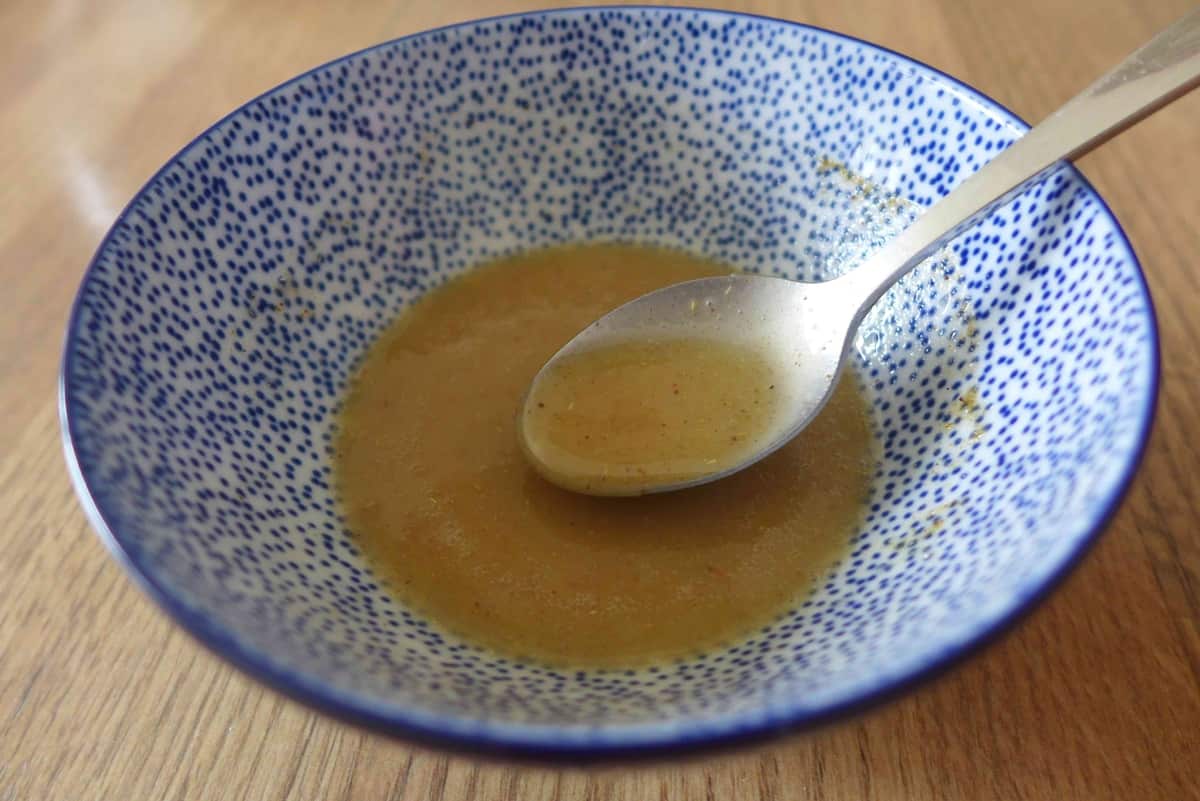
In a small bowl, combine the fat/oil, flour, salt and spice into a smooth paste. If using lard or coconut oil, melt it first then mix.
Assemble
Now it’s time to assemble the pancakes.
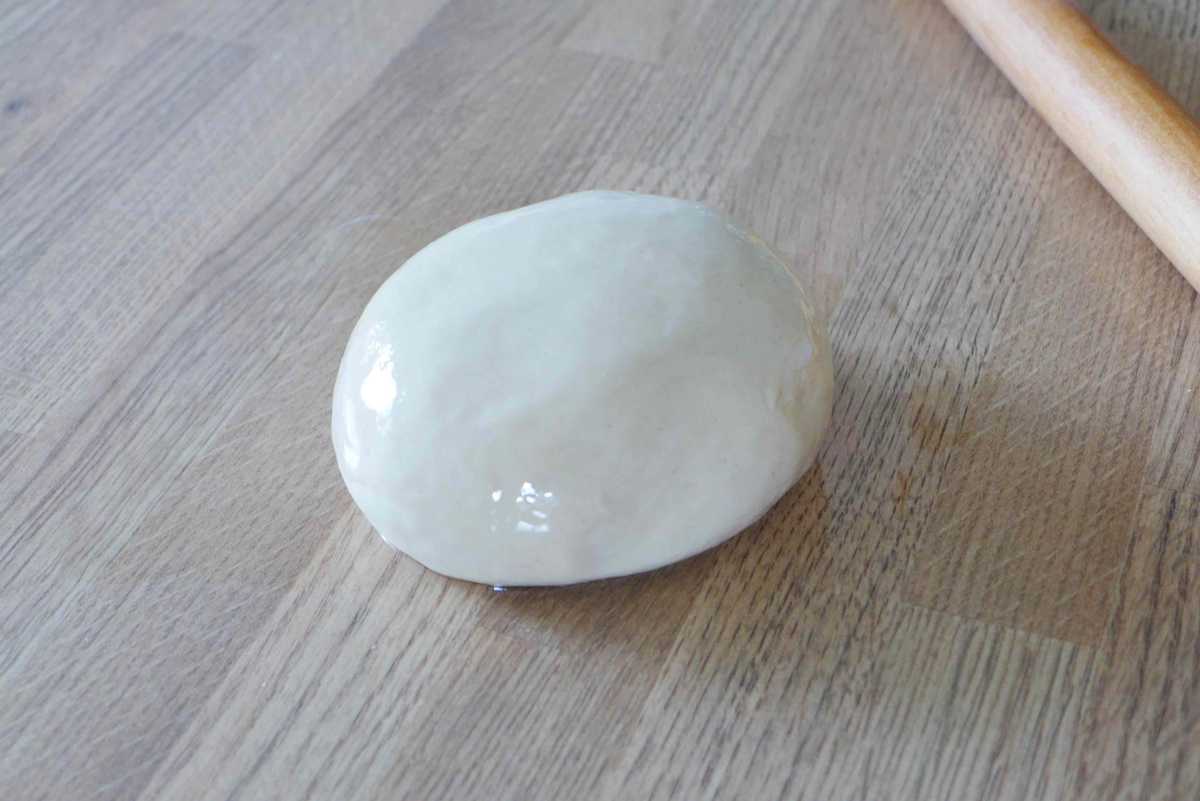
To prevent the dough from sticking, apply a thin layer of oil over the entire dough and the board/work surface you’re using (The same technique used for Crispy Stuffed Flatbread). Dusting with flour could serve the same purpose but I find it often makes the dough drier.
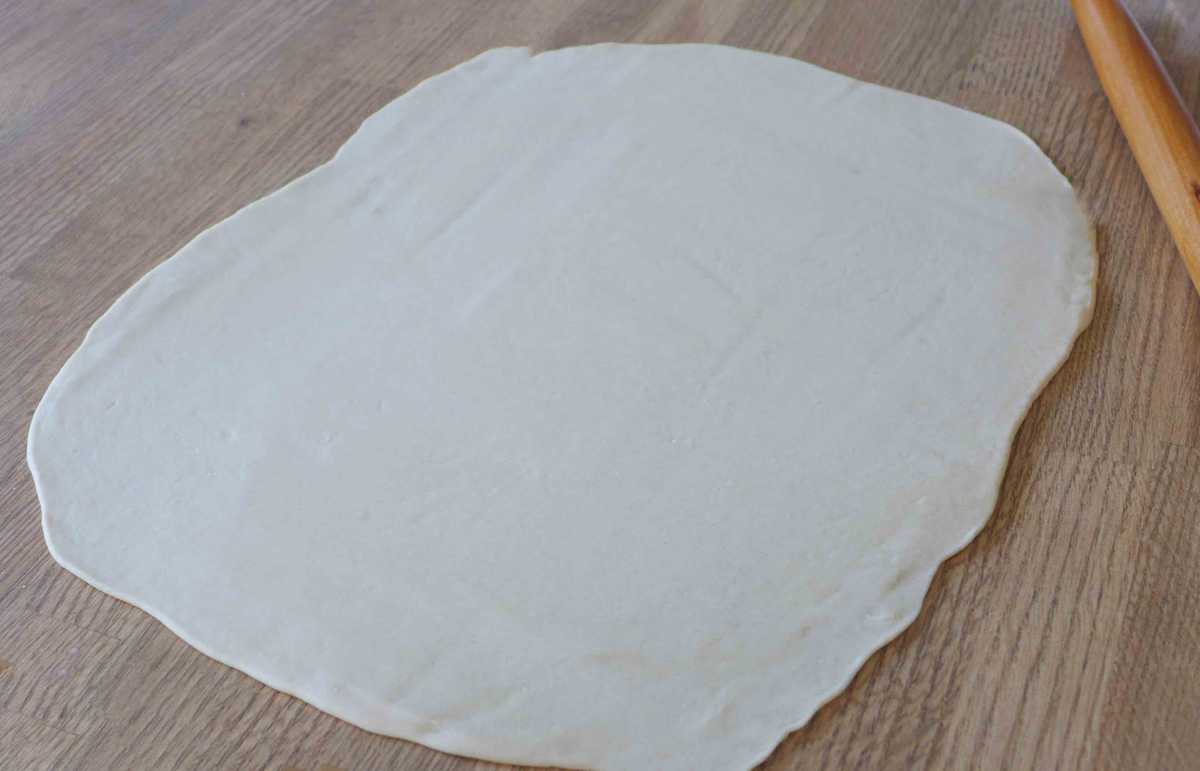
With a rolling pin (any type), press the dough, then gently push it in all directions to flatten it into a thin rectangle piece. For your reference, mine measures about 43cm(17″) by 33cm (13”).
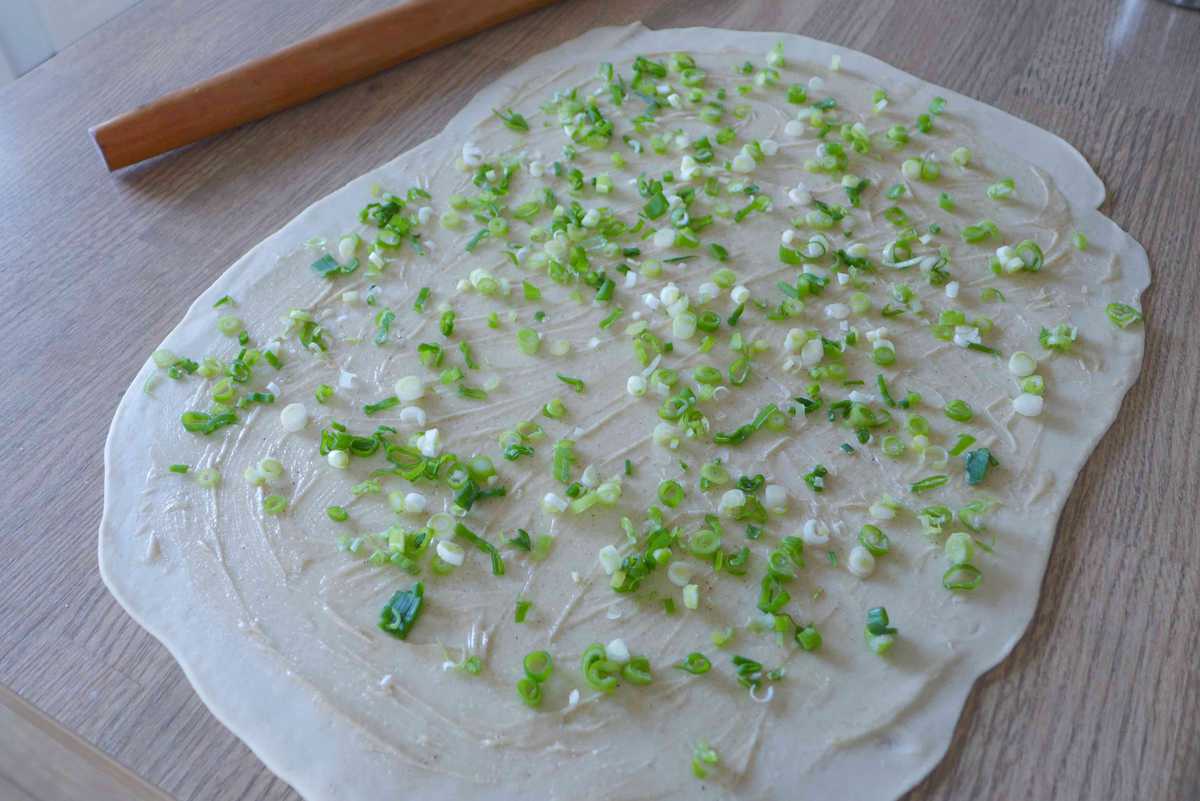
Use the back of a spoon or a brush to evenly spread the filling mixture over the dough. Sprinkle the chopped scallions on top.
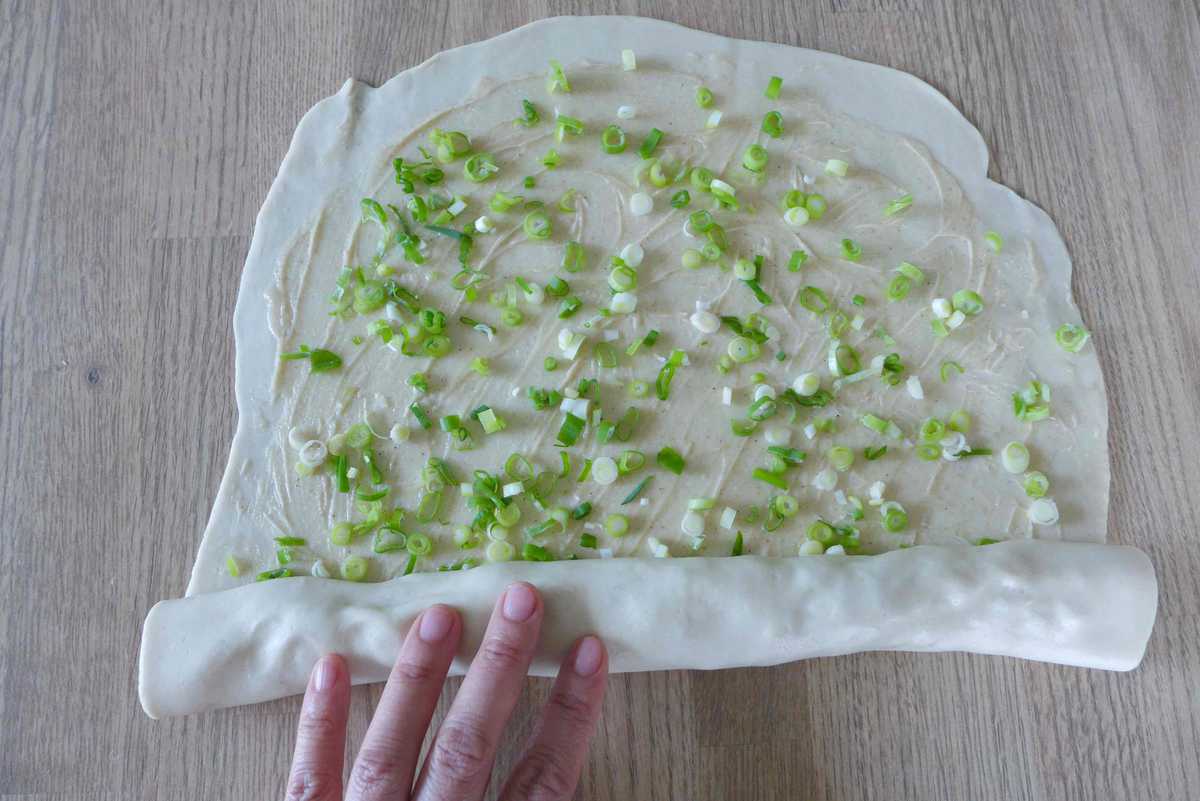
From the shorter side of the dough, loosely roll the dough into a rope.
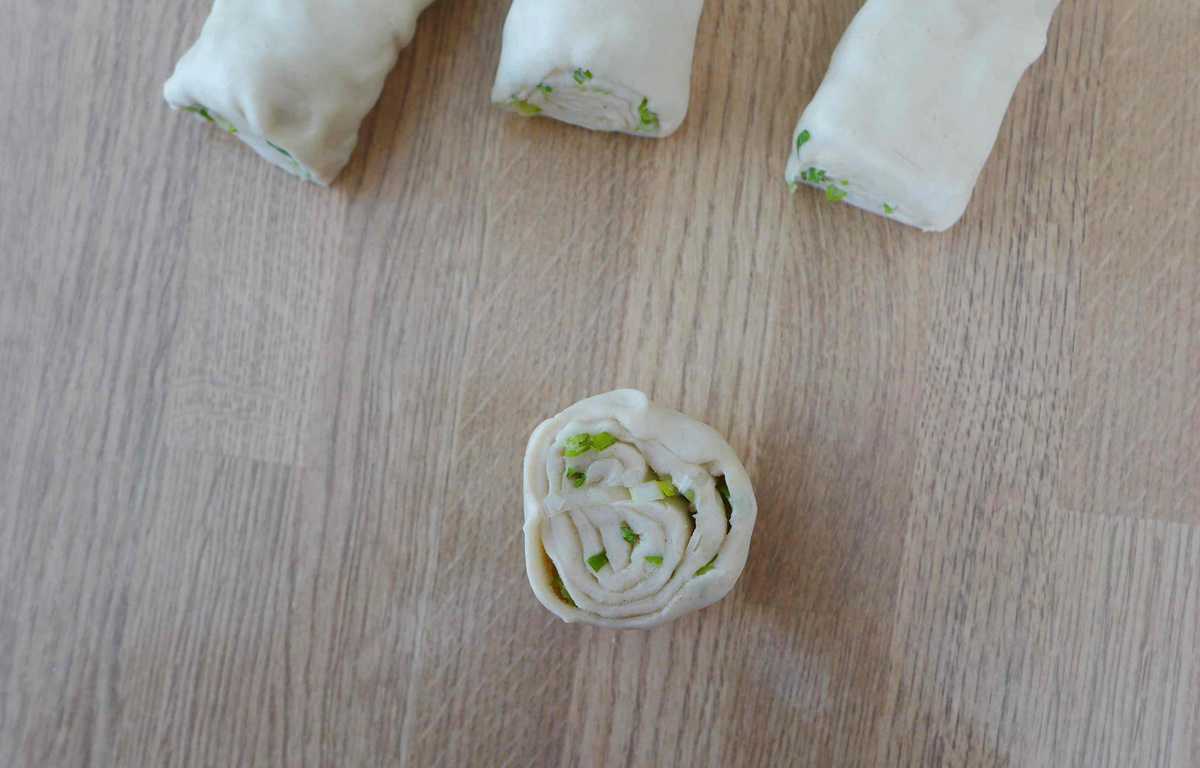
Then cut it into sections. Stand up one piece with the cut side facing up.
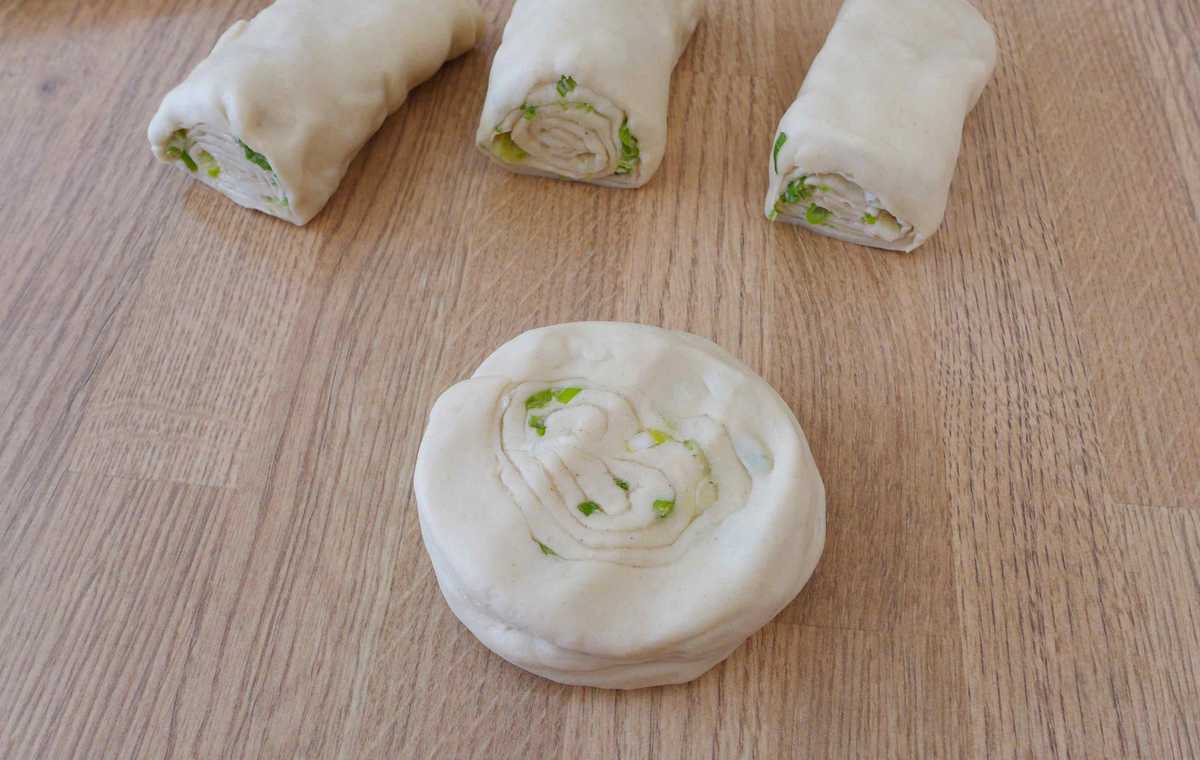
Press with your fingers then roll it flat with the rolling pin.
Thick or thin?
How thin should I roll my pancakes? You may ask. I showcase two options in this recipe. Choose whichever you fancy!
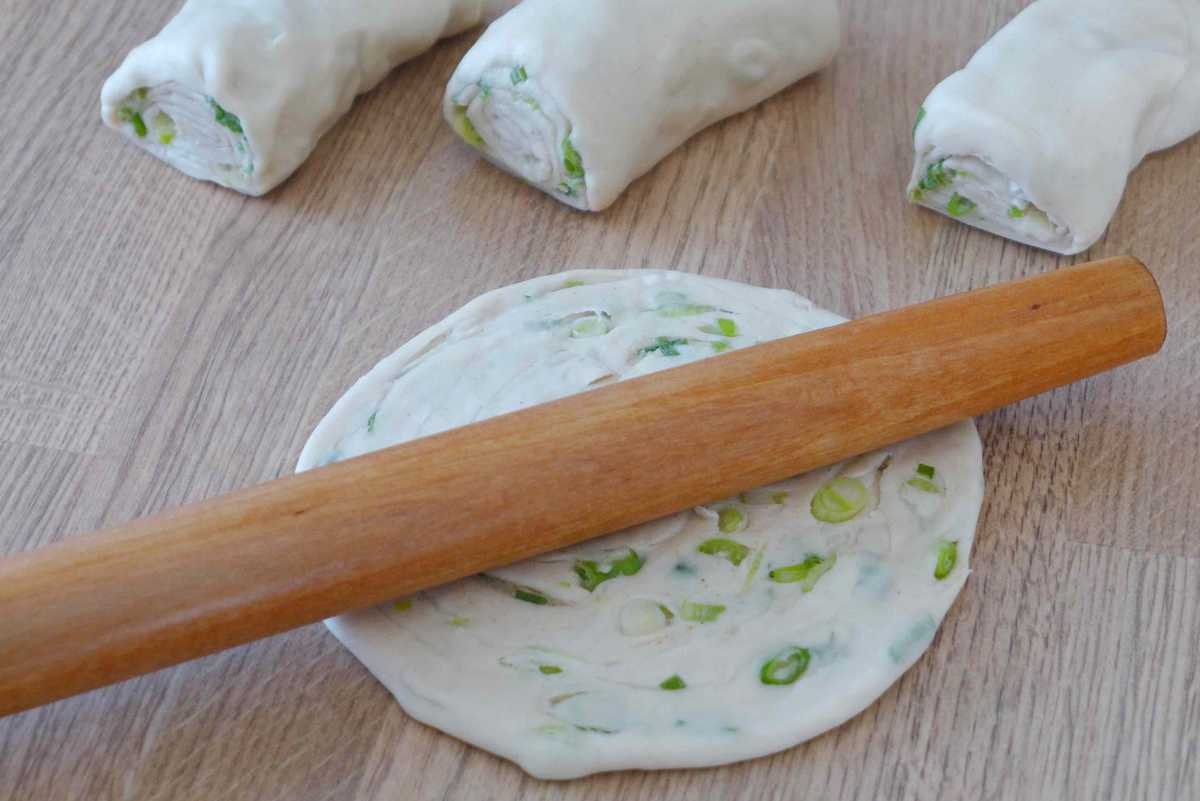
- The thick version: Divide the rolled dough into 4 sections. Each flattened pancake measures about 13cm/5″ in diameter and ½ cm/ ⅕” thick. Four pieces fit in a large frying pan so you can cook all at once. They’re crispy on the surface but soft in the middle, so you get a contrasting texture in every bite.
- The thin version: Divide the rolled dough into 3 sections. Flatten each piece as thin as possible (Mine measures about 23cm/9” in diameter). This is a more traditional look (my parents always make them this way). Compared to the thick version, they offer a pleasant chewier texture.
Pan-fry
Similar to how you cook Chinese Meat Pies, it’s easy to pan-fry scallion pancakes. But to achieve the perfect texture, crispy but not dry, you’d need to pay attention to three things: control the temperature, cover the pan and watch the timing.
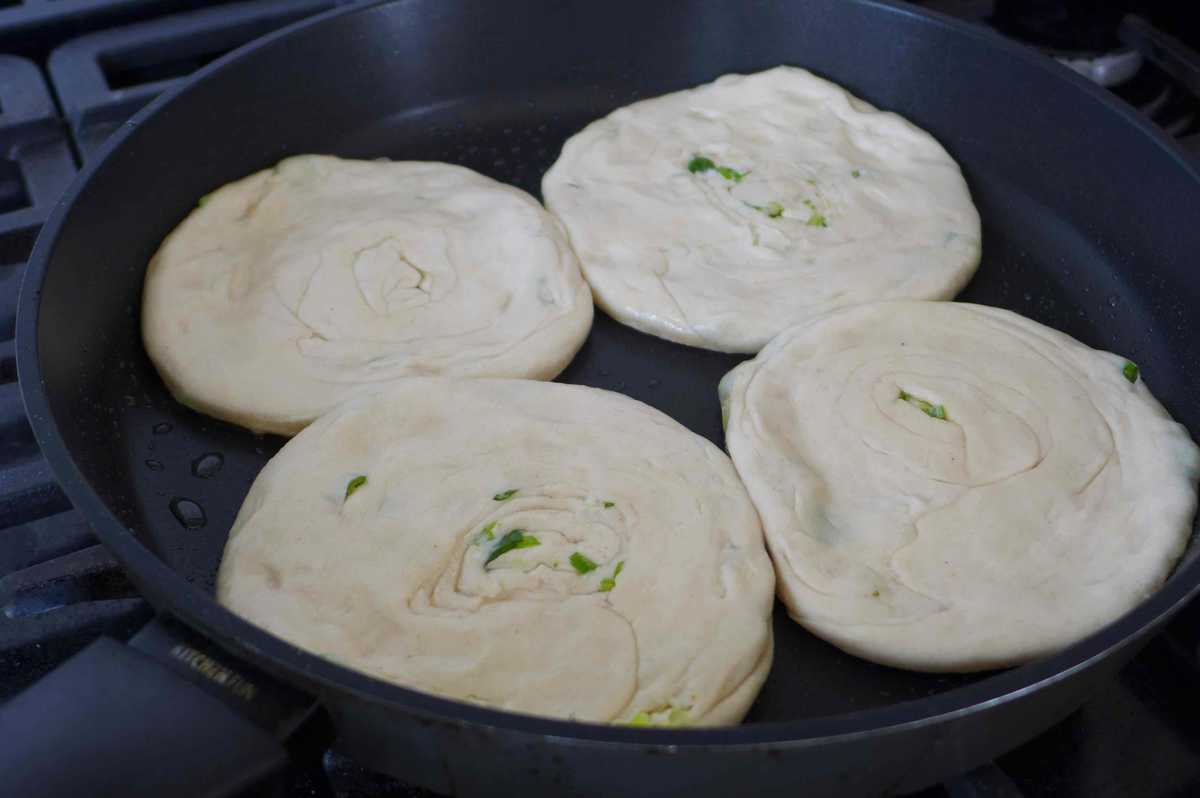
Heat oil in a frying pan/skillet over high heat until hot. It’s important to have a hot pan when you place the pancakes in. Otherwise, the dough tends to soak up more oil resulting in a greasy taste. Drop a piece of scallions, or a sesame seed, to test. If it sizzles, the oil is hot enough.
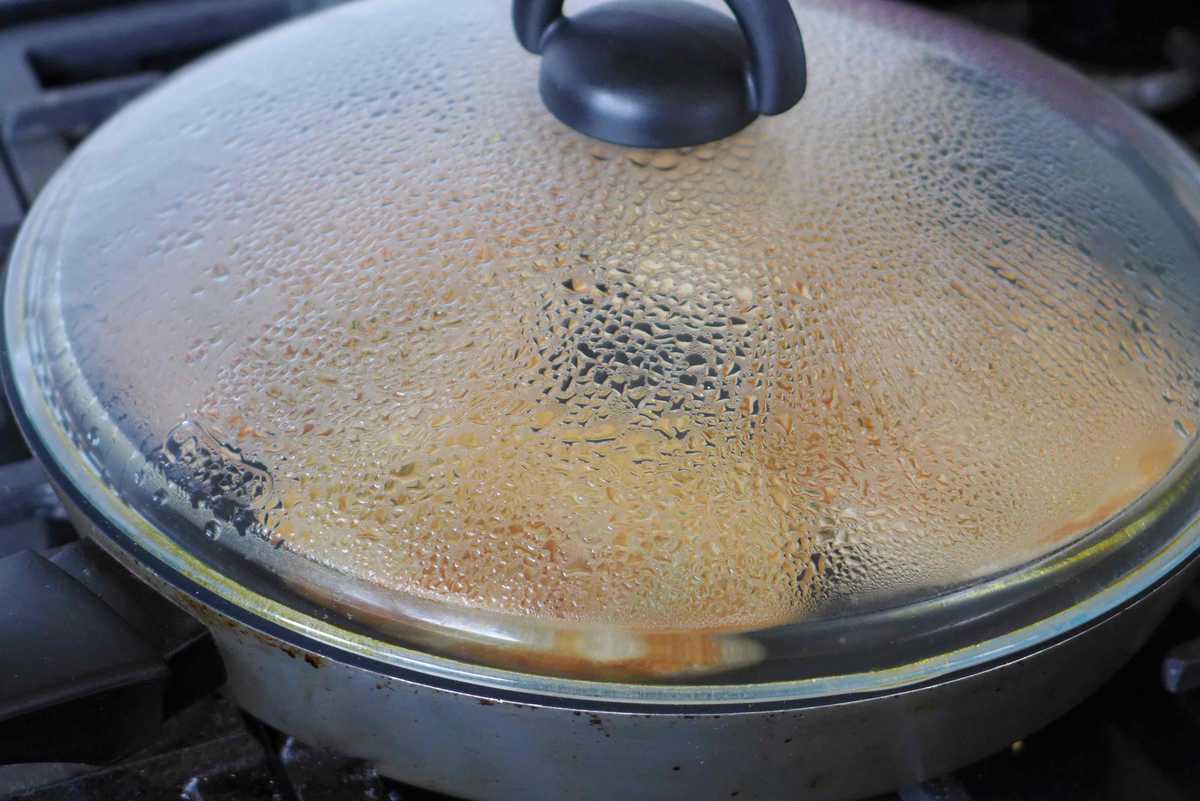
Once you put the pancakes in, remember to adjust to medium-high heat. Then cover the pan with a tight lid. This helps to cook them evenly without losing much moisture. If the temperature remains high, the outer layer will get burnt before the inner part is fully cooked.
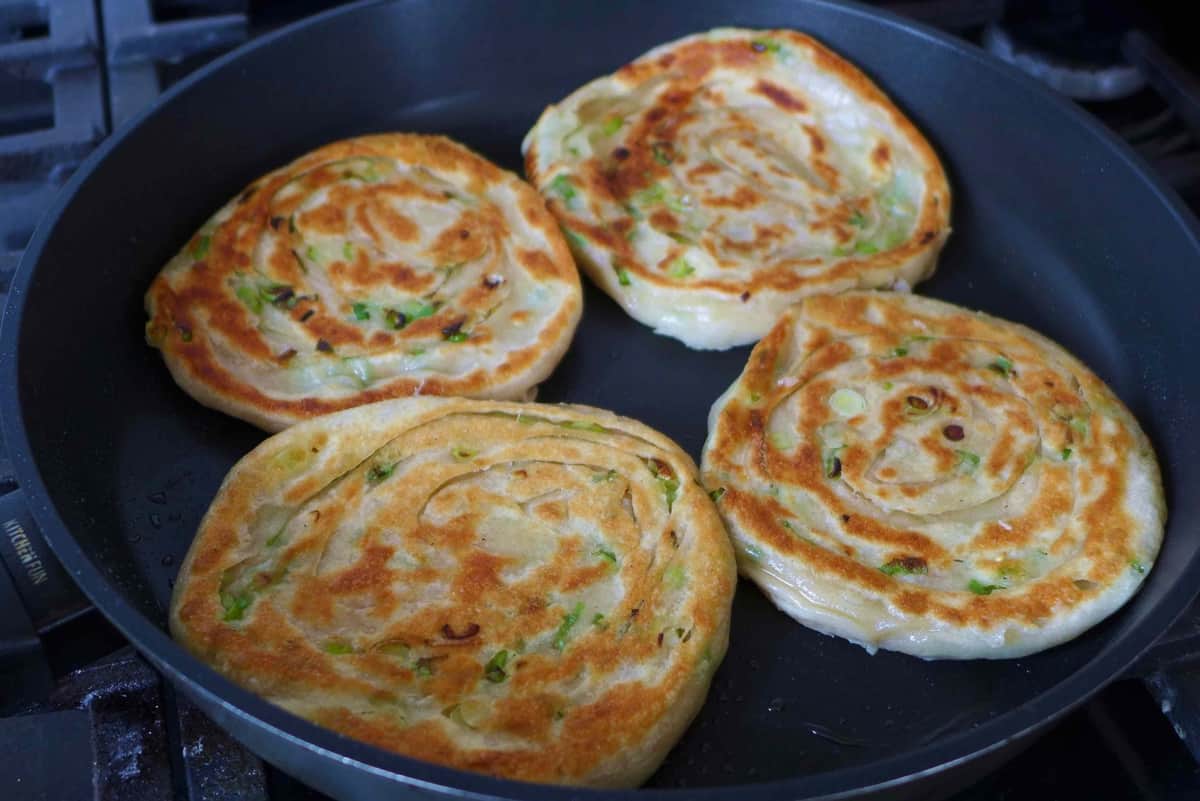
When the first side becomes golden brown, flip over to cook the other side (always have the lid on). It took me about 4 minutes to cook both sides for thick pancakes. Thin pancakes would take less time. But the cooking time may vary in your case. Check the donees more often if unsure.

If available, use a wire rack to rest the pancakes for a short while before serving. If placed on a plate right away, condensation will form making them soggy. Also, if your pancakes are thick, the remaining heat cooks the inside further.
🛎 TIP: It’s fine to cook these pancakes without oil (I often do so to reduce oil intake), like how I pan-bake the flatbread for Rou Jia Mo (Chinese pork burger).
Serving ideas
If you’ve made thick pancakes, tear them into pieces to eat. Whereas the thin version is often sliced into wedges, just like how you cut a pizza (see image below).
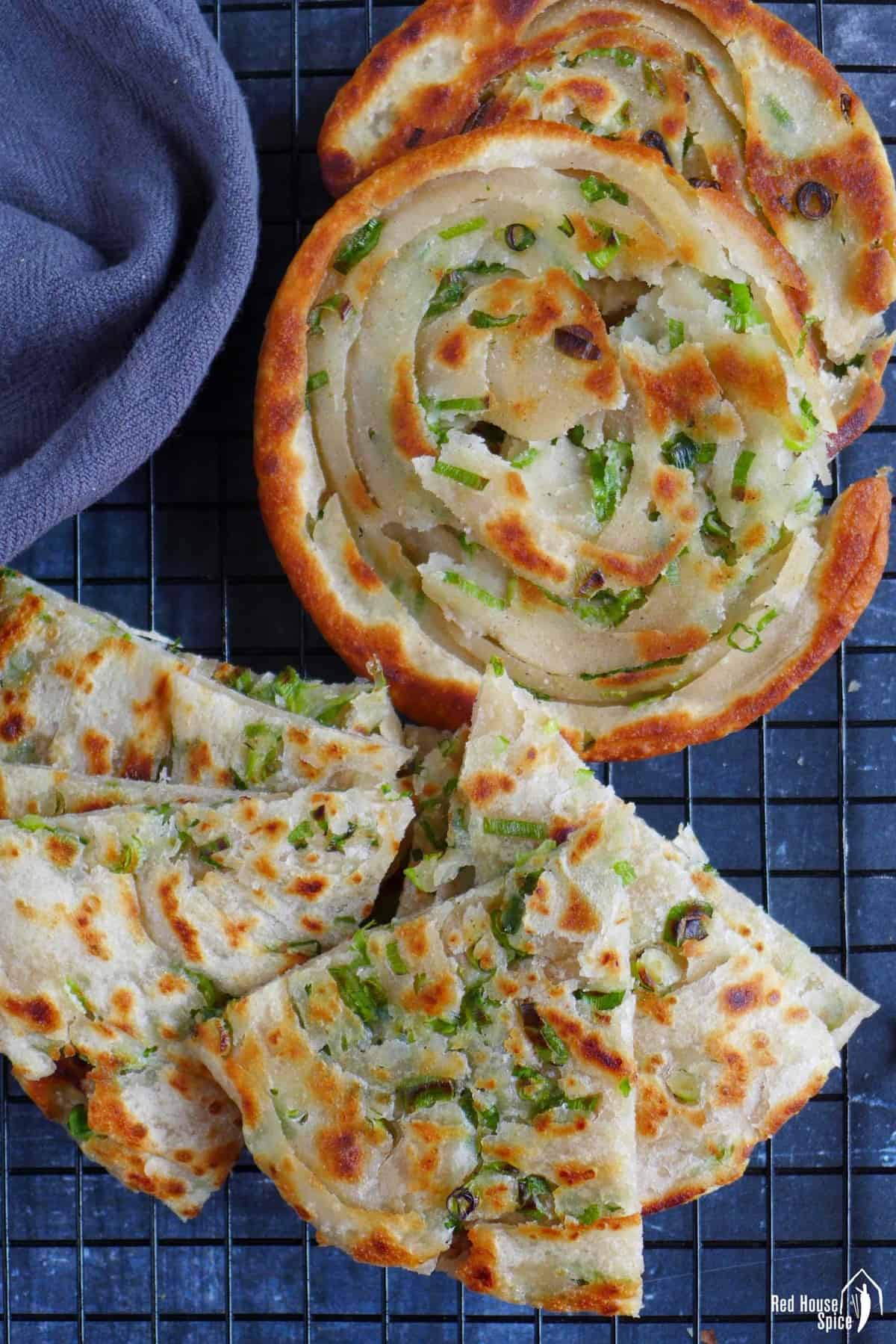
I grew up eating scallion pancakes as part of a multi-dish meal when we weren’t having steamed rice as a staple. It was usually paired with a few savoury dishes and congee or soup. We also ate them as breakfast or afternoon snacks.
Scallion pancakes sold in Chinese restaurants sometimes come with a dipping sauce. If this is what you prefer, you can get inspiration in my post on dumpling sauces. Alternatively, just dip them in Chinese chilli oil, with or without the company of black rice vinegar, light soy sauce, etc.
Make ahead
Do you know that uncooked scallion pancakes freeze well? If you plan to eat them regularly, I suggest you make a big batch at once following these steps:
- Multiply the quantity of the ingredients proportionally.
- Make the dough then stuff and shape the pancakes.
- Pile them up using parchment paper to separate each piece to prevent sticking.
- Put them in airtight bags and store in the freezer.
Whenever you fancy a piece, simply pull out one and pan-fry following the same method without defrosting. If your pancakes are on the thick side, add a little water to the pan before you put the lid over the pan. The steam will help cook the middle part thoroughly, just like how you make pan-fried Chinese dumplings.
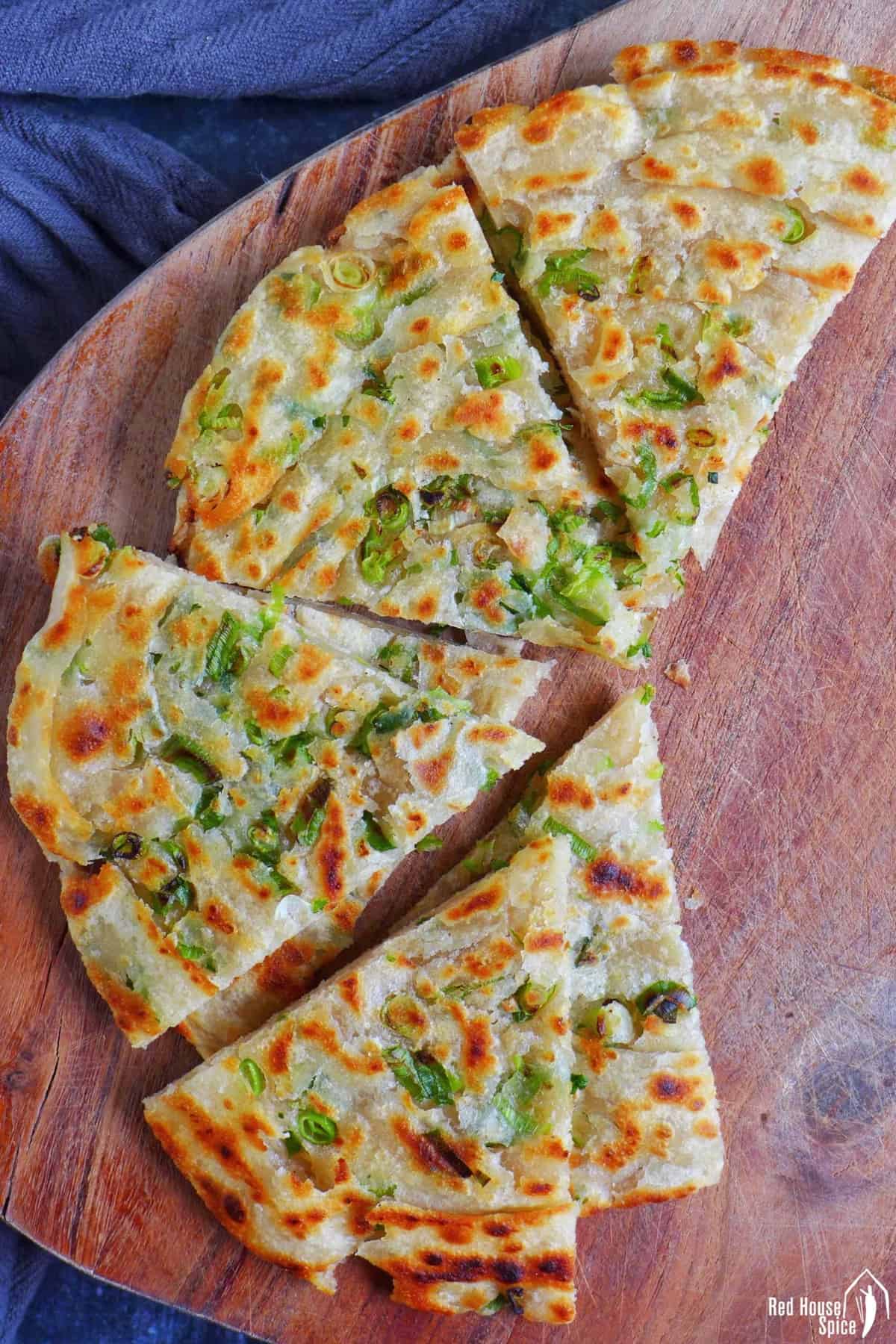
Recipe FAQs
A: There are a few things that could cause doughy, dense texture. Make sure:
1) The pancakes aren’t too thick; 2) The heat isn’t too high or too low. If too high, they’re cooked unevenly. If too low, it takes too long to cook so they become dry; 3) The lid is tight so there isn’t too much steam escaping from the pan.
A: You can easily adapt this recipe with yeast-leavened dough. Try my recipe for Pan-baked Scallion Flatbread and Oven-baked Scallion Bread (see image below). They’re equally delicious!
A: Yes, you can either refrigerate or freeze the dough. Coat with a thin layer of oil and wrap tightly with cling film. Store in air-tight bags/containers. Defrost and bring to room temperature before shaping.
Other classic staples
📋Recipe
Love this recipe? Please leave a 5-star 🌟🌟🌟🌟🌟 rating in the recipe card below & if you REALLY like it, consider leaving a comment as well!
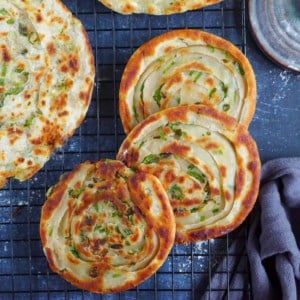
Scallion Pancakes (Cong You Bing, 葱油饼)
Ingredients
For the dough
- 250 g all-purpose flour (plain flour) - about 2 cups (see note 1 for substitutes)
- 160 g hot water - about ⅔ cup
- Cooking oil - for coating
For the filling
- 2 tablespoon melted lard - or coconut oil, see note 2 for other substitutes
- 2 tablespoon all-purpose flour (plain flour)
- ¼ teaspoon ground Sichuan pepper - or Chinese five-spice powder
- ¼ teaspoon salt
- 40 g finely chopped scallions (green onion/spring onion) - about ½ cup
For frying
- 1 tablespoon neutral cooking oil
For serving (optional)
Instructions
Make the dough
- Put flour into a heatproof bowl. Pour in hot water. Stir with chopsticks until no more loose flour or water can be seen. Use your hands to combine the mixture into a rough-looking dough (see note 3).
- Tightly cover the dough with cling film and leave to rest for 15 mins.
Prepare the filling
- While waiting, add melted lard (or other oil), flour, Sichuan pepper (or five-spice) and salt to a small bowl. Mix until it becomes a smooth paste.
Shape the pancakes
- Uncover the dough then knead until it becomes very smooth. Rub a thin layer of oil around the dough, as well as the work surface.
- With a rolling pin, flatten the dough into a thin, rectangular piece. For your reference, mine measures about 43cm(17") by 33cm (13").
- Brush the filling mixture over the dough, then sprinkle finely chopped scallions on top.
- From the shorter side of the dough piece, roll the dough into a rope (don’t make it too tight).
- Cut the rope into 4 cylinders. Stand a piece on one end. Press down with your hand, then flatten it with the rolling pin into a pancake that measures around 13cm/5” in diameter. Alternatively, cut the rope into 3 parts and roll each into a thinner pancake which measures about 23cm/9”.
Fry the pancakes
- In a frying pan/skillet, heat oil over high heat until hot. Drop a piece of scallions in to test. If it sizzles, the oil is hot enough.
- Turn the heat down to medium and put in the pancakes (the top side facing down). You may cook 4 thick pancakes all at once in a large pan (28cm/11"), or 1 thin pancake at a time.
- Cover with a lid and leave to cook for about 2 minutes until the side facing down becomes golden brown (adjust the cooking time if necessary). Flip over to cook the other side (keep the lid on). Remove them from the pan once the second side turns golden too.
- For the best result, rest the pancakes on a wire rack for a minute or two before serving (condensation will form if placed on a plate straightaway). Also, the remaining heat will cook the inside further during the resting time.
Serve
- The thick version can be served as it is and torn apart to eat. The thin version is often cut into triangular pieces.
- Although they are tasty on their own, a dipping sauce would make a great accompaniment, e.g. a simple mixture of homemade chilli oil, black rice vinegar and light soy sauce.
- Store leftover pancakes in airtight bags in the fridge for up to 3 days. Reheat in a pan/oven/air-fryer.
Make ahead
- To make a big batch and cook later, double or triple the recipe proportionally. Freeze uncooked pancakes right after they’re rolled out. Pile them up with parchment paper in between and store in sealed plastic bags.
- Cook frozen pancakes without defrosting following the same method. If they’re thick ones, add a little water while cooking with the lid on (like how you make pan-fried dumplings).
Video
NOTES
NUTRITION
NUTRITION DISCLOSURE: Nutritional information on this website is provided as a courtesy to readers. It should be considered estimates. Please use your own brand nutritional values or your preferred nutrition calculator to double check against our estimates.



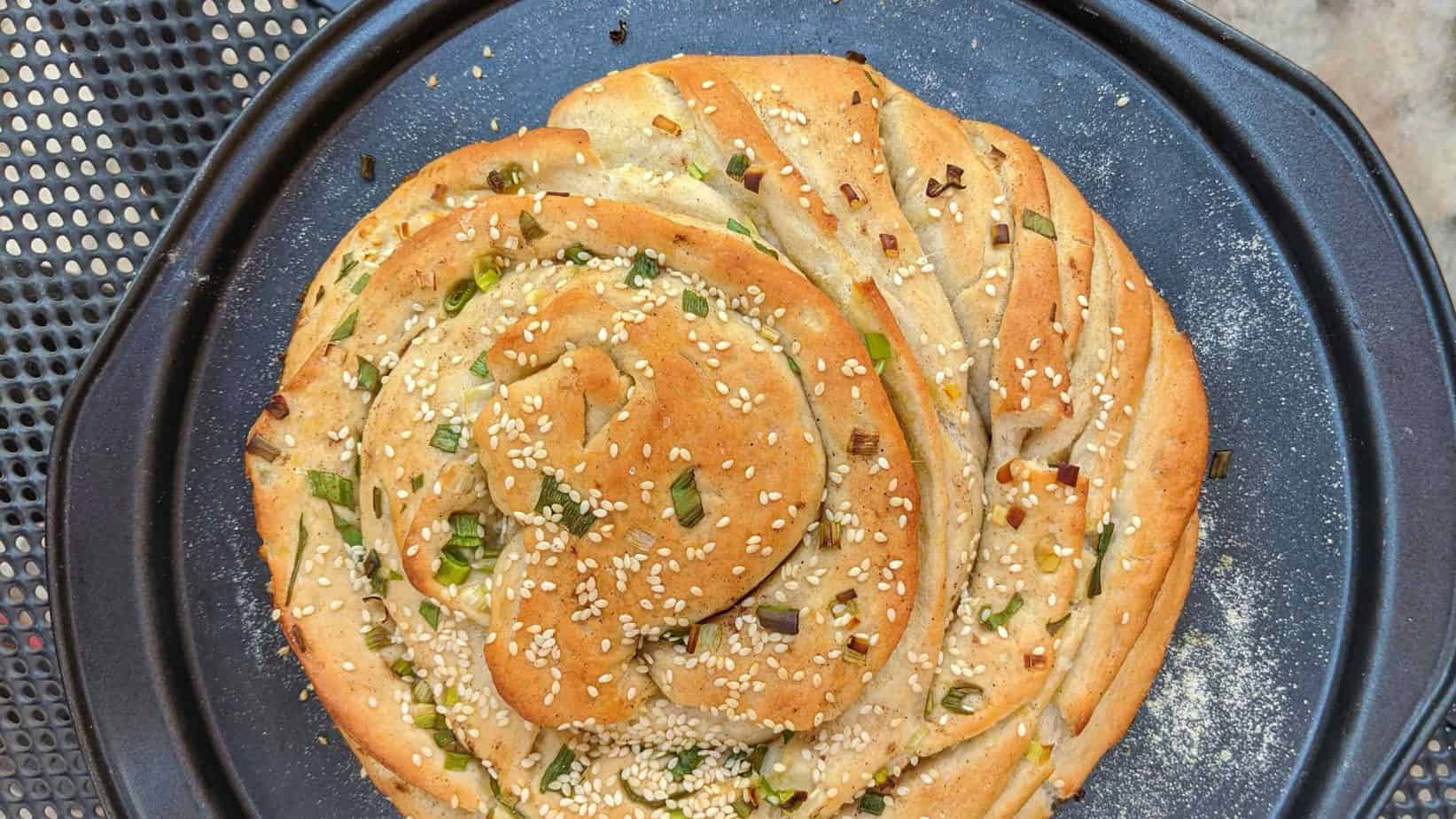
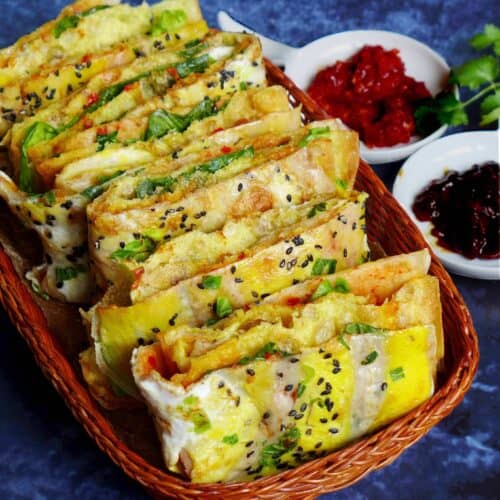
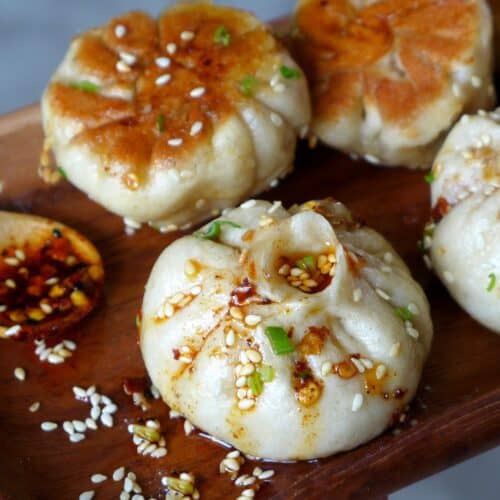
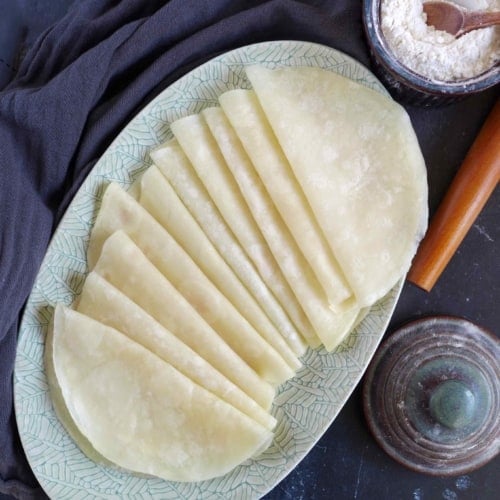
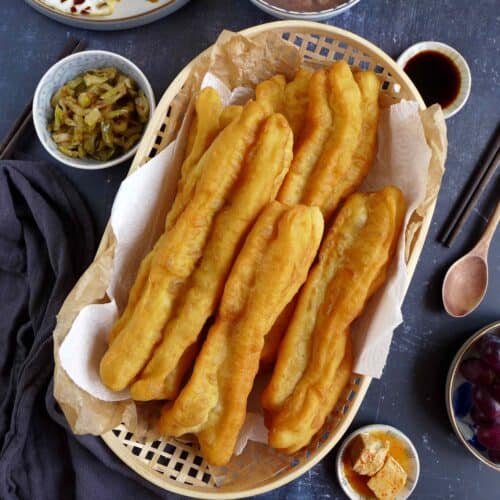
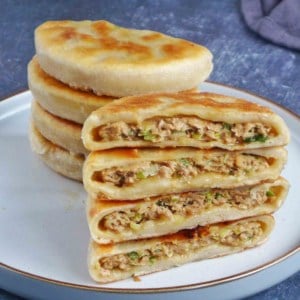
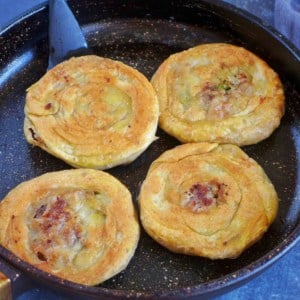
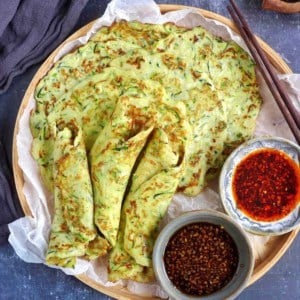
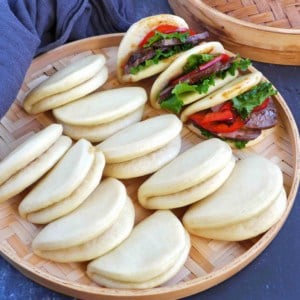
Hi Wei! I was wondering if I could use any other types of oil in place of lard/coconut, such as olive or canola? Thanks!
Yes Eve, you may use other types of oil. Happy cooking!
Hi. I live in Changchun, Jilin and found something similar that was baked with an egg in the middle. Any idea how I would alter this recipe to do that or is that an entirely different recipe?
According to your description, it could be Ji Dan Guan Bing/ 鸡蛋灌饼 which is a different dish. You would not be able to do exactly the same (add an egg in the middle) with this recipe.
Amazing!!!
Fiz e ficaram ótimas! A culinária chinesa é fantástica!
Google Translate helped me to understand your words: “I did and they were great! Chinese cuisine is fantastic!” Glad to know you’ve enjoyed my recipe!
I look back to the olden days, how nice.
This recipe is perfect. I tried others but I didn’t like that they were too thin.
The coconut oil suggestion is great for vegetarians.
A minor problem that I had was that the flour and oil stuck together when I tried to mix the filling together. Did I use too much flour?
Hi Norea! Happy to know my recipe worked well for you. The filling should be very easy to spread. I suggest you reduce the flour a little.
I made these and they were very good.
When I was rolling the dough out for the pancakes, the dough was rebounding a bit.
Is there a way to prevent this? Like kneading more?
Thanks!
Hi Paul! This can be caused by the high gluten level of the flour or over-kneading. Here is the solution: After you shape and cut the dough into cylinders (as described in the recipe), leave them to rest for a few minutes then flatten them with a rolling pin. They will be much easier to roll out.
Hi 250g is about 1 cup of flour. Currently it says 2 cups, so it would be correct to double the water. I was kneading the dough for so soon and it would not stick. Had to throw it out and google how much 250g was.
Hi Mochi! 1 cup of flour weighs about 125g flour. Please check it out on a “Cups to Grams Converter” site.
Measuring flour by volume is very inaccurate since flour can be easily compacted into the measuring cup without you knowing.
I’ve had a lot of success measuring flour by weight.
Can these be made with whole wheat flour? Thank you.
This recipe is not suitable for whole wheat flour as you won’t get an elastic dough thus the look and texture would be very different. But you can add whole wheat to white flour (I’d suggest no more than 30%). Make sure you adjust the water volume accordingly.
Thank you for responding so quickly. I can’t wait to try this.
Would you eat these standing alone or would you serve this with something else? If serving it with something else then what?
In Chinese households, they are eaten either on their own or with other dishes. Considered the staple food of a meal, they would go well with any savoury dishes that you usually serve with plain rice. There aren’t any set rules.
For breakfast, they are usually served with rice congee, soy milk, etc.
Lovely! No idea how they should taste, but what I prepared for breakfast based on this recipe was great! Next time I will add more srping onion and sichuan pepper. We ate them with easy Chinese dressing which was tasty. And it wasn’t difficult, even the rolling part.
Brilliant! Always a good idea to add more spring onion and Sichuan pepper if you like big flavour.